When reading President Trump’s America First Energy policy, a line that really stood out was his position on the EPA’s role: ‘He will refocus the EPA on its essential mission of protecting our air and water.’ So I looked up the EPA mission statement, which is very concise but is also broken out further into bullet points if you care to read them. ‘The mission of EPA is to protect human 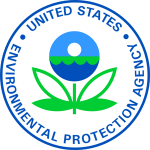 health and the environment.’ This mission seems to directly contradict the President’s desire to cut two parts of the EPA: Climate Action Plan and Waters of the U.S. Rule. He stated in the America First Energy Plan that they were ‘unnecessary’ and ‘harmful’ policies and that by lifting them American wages would increase by $30 billion over 7 years.
health and the environment.’ This mission seems to directly contradict the President’s desire to cut two parts of the EPA: Climate Action Plan and Waters of the U.S. Rule. He stated in the America First Energy Plan that they were ‘unnecessary’ and ‘harmful’ policies and that by lifting them American wages would increase by $30 billion over 7 years.
For the purpose of this post I’m going to take the generally accepted scientific view that Climate Change is real and widely thought to be influenced by greenhouse gases.
PROXY (INDIRECT) MEASUREMENTS
Credit: NOAA
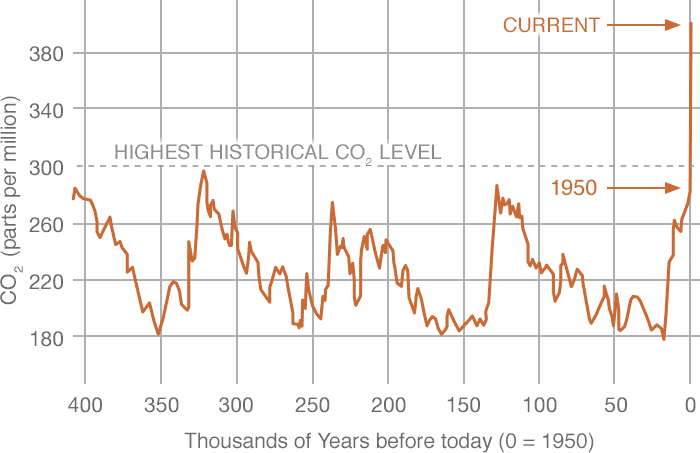
Now let’s talk about President Obama’s Climate Action Plan. The Climate Action Plan was released in June 2013.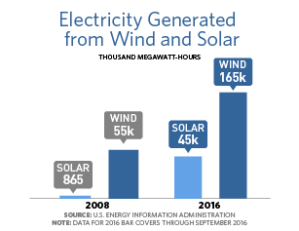
- It directs the EPA to establish carbon standards for several industry leaders.
- Provides $8 bil in loan guarantees to efficiency projects for fossil fuels.
- Directs agencies to develop a methane strategy.
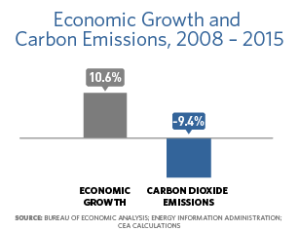
- Commits to partnering with industry leaders to develop economy fuel standards for heavy-duty vehicles.
- Sets a goal across federal buildings and appliances to reduce carbon admission by 3 billion metic tons by 2030.
- And further commits to reducing hydrofluorocarbons.
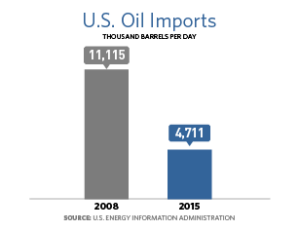
Does that fit with the EPA’s mission? Remember what the mission statement is “…protect human health and the environment.” What is such a sharp rise in carbon dioxide doing to human health? Here is a book published for a climate workshop by the Institute of Medicine called Global Climate Change and Extreme Weather Events: Understanding the Contributions to Infectious Disease Emergence: Workshop Summary. The following is an excerpt from the chapter on policy implications of the health effects of climate change and extreme weather events: “Climate change does not act in isolation, but is likely to interact with other rapid changes to strain existing weak points in public health systems. The most effective response is likely to be the strengthening of key functions, such as environmental management, and surveillance and response to safeguard changes in infectious disease patterns and other hazards.” An example of another hazard is food security.
Here is a list of the way food security can be compromised by climate change:
- Smaller Yields – Extreme weather events can affect water amounts for plants (too much or drought).
- Processing, Storage, & Transportation Problems – With the globalization of the food market, as of 2013 the value based import of food was 20% of the United States supply (and 100% for certain items such as oils & spices), climate events abroad have an affect.
- Food- and Waterborne diseases – Extreme weather events impact the production and spread of food related parasites and diseases.
- Higher Food Prices – With decreased yield, higher transportation costs, and more food needed (globally with the increase in population) that translates to high cost. Which disproportionally affects the areas of our nation that already have a higher food security problem currently, from lack of economic standing.
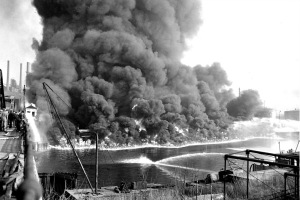 The Cuyahoga River Fire of 1969, inspired the formation of the EPA and Earth Day. The 1969 fire was not the first time or the most destructive time the Cuyahoga caught on fire. The Clean Water Act of 1972 was soon passed, which mandated that the water should be safe enough for mass amounts of swimmers and fish to be in the waterways by 1983. Let’s put some of the protections it affords us into perspective. It provides the regulations for dumping of waste for oil and hazardous substance into any portion of our country that connects to our waterways (what we use for drinking water). But that does not include most ditches, farm ponds, or puddles. We are talking about rivers, tributaries, wetlands, and headwaters. What might be the motivation behind getting rid of the rule? Three very large industries: oil, agriculture, & construction.
The Cuyahoga River Fire of 1969, inspired the formation of the EPA and Earth Day. The 1969 fire was not the first time or the most destructive time the Cuyahoga caught on fire. The Clean Water Act of 1972 was soon passed, which mandated that the water should be safe enough for mass amounts of swimmers and fish to be in the waterways by 1983. Let’s put some of the protections it affords us into perspective. It provides the regulations for dumping of waste for oil and hazardous substance into any portion of our country that connects to our waterways (what we use for drinking water). But that does not include most ditches, farm ponds, or puddles. We are talking about rivers, tributaries, wetlands, and headwaters. What might be the motivation behind getting rid of the rule? Three very large industries: oil, agriculture, & construction.
Finally let’s tackle that wage statistic – American wages would increase by $30 billion over 7 years. You might wonder where that wage statistic comes from, as I did. That took me more than a few minutes to track down. Here is what I learned – a finance professor from Louisiana State University wrote a study in 2015 that has flawed research and incomplete data. Here is a link to the study, and an article outlining the problems with the methodology, assumptions, and data collection, and a more appropriate study by the Congressional Budget Office. The aptly named Congressional Budget Office Study – Potential Budgetary Effects of Immediately Opening Most Federal Lands to Oil and Gas Leasing – came to the conclusion that they (CBO) cannot accurately project revenue beyond the year 2022 (except the Alaskan reserve) because they lack the data needed.

The CBO study also found that accelerated leasing of off-shore reservers would not affect overall development over the next several decades. Let’s also talk about what $30,000,000,000 over 7 years per 152,000,000 working Americans looks like, but let’s also not forget the inflation rate of 2.5% per year. Inflation for the next 7 year is 17.5%. While spreading $30 bil over the American work force and removing inflation at a static rate that is a net increase of $23 per worker per year.
Let me just recap, I found that the EPA’s mission is in line with the Climate Action Plan and Waters of the U.S. Rule and that neither plan was ‘unnecessary’ or ‘harmful’ – unless you consider ‘harmful’ to mean that industry should have the ability to pollute drinking water. And that the very quotable statistic about more money for American workers is not all it is cracked up to be.
Please feel free to leave comments either about the EPA, Climate Action Plan, Waters of the U.S. Rule, or distracting statistics!
Note 1:
Let me just add as a side note that I had quite a time trying to find the 2015 paper that everyone was citing. All the articles kept telling me it was written in 2015 by a finance professor from Louisiana State University, but they would never give the paper’s name or the professor’s name. After multiple searches for news articles I found one that I knew had plagiarized sentences straight out of the paper in question. One sentence I never thought I would say in my life, “Thank god for plagiarism.” I lifted that sentence out of the news article an popped it into Google and sure enough the paper was the first link!
Note 2:
A very cool population counter – American population by the Census.Gov Page!